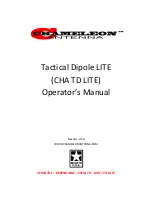
CHA TD LITE
Page 8
6.
Connect the Carabiner from the Wire Connector
end of the other Antenna Wire to the Carabiner
from step (4).
7.
Connect the Wire Connector from the Antenna
Wire to the Top Transformer Connection (h).
Tighten the wing nut finger tight.
8.
Using a Bowline or similar knot, tie one end of a
long length (around 50 feet) of Paracord to the
Carabiner from step (6).
9.
Connect the UHF Plug from the Coaxial Cable to
the UHF Socket (g) on the Matching
Transformer.
Raise the antenna.
10.
Using a throw weight or some other method,
loop the long length of Paracord over the
support.
11.
Raise the antenna to the desired height and
secure the Paracord to the support with a
Round Turn and two Half Hitches, or similar
knot.
Extend the Antenna Wires into a “V”.
12.
Using a Bowline of similar knot, tie a short
length of Paracord (around 4 feet) to Isolation
Loops (c) at the unconnected end of both
Antenna Wires.
13.
Extend one Antenna Wire to its full length.
14.
Drive a Stake in the ground around two feet
beyond the end of the Antenna Wire.
15.
Using two Half Hitches, tie the short length of
Paracord from the Antenna Wire to the Stake,
such that the Antenna Wire is not quite taut.
16.
Extend the other Antenna Wire to its full length
along the approximate opening angle chosen to
form the antenna into a “V”
(60 feet between
the ends of the “V” for 90°)
.
17.
Drive a Stake into the ground around two feet
beyond the end of the Antenna Wire.
18.
Tie the Paracord from the Antenna Wire to the
Stake, such that the Antenna Wire is not quite
taut.
19.
Perform operational test.
Horizontal Dipole
The CHA TD LITE Horizontal Dipole configuration, see figure (3), is a broadband short to long range HF antenna.
The Horizontal Dipole is the standard for wire HF antennas and will provide good sky wave (including NVIS)
propagation. It requires at least two supports (one at each end). A center support is also recommended. The CHA
TD LITE Horizontal Dipole should be mounted at a height of around 25 feet for good overall results. When mounted
at this height, on lower frequencies the antenna tends to be bidirectional broadside to the antenna. The pattern
becomes a clover leaf at higher frequencies. If the ends of the antenna are sloped down to the ground, the
antenna becomes an Inverted “V”
(see Sloping “V” configuration)
.
Figure 3. Horizontal Dipole Configuration.



































